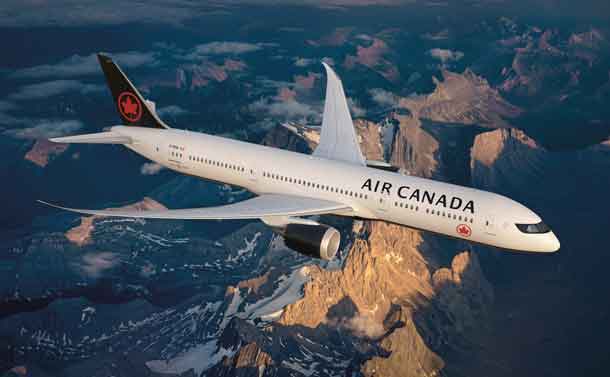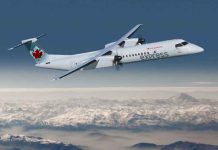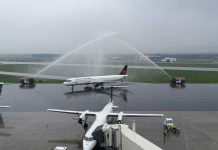TORONTO – BUSINESS – Air Canada has reported first quarter 2017 EBITDAR(1) (earnings before interest, taxes, depreciation, amortization, impairment and aircraft rent), excluding special items, of $342 million, compared to first quarter 2016 EBITDAR of $460 million. The airline recorded a first quarter EBITDAR margin of 9.4 per cent, better than the margin projected in Air Canada’s February 17, 2017 news release. The better than expected EBITDAR margin performance was primarily driven by a first quarter revenue environment that was more robust than anticipated, lower than forecasted aircraft maintenance expense largely due to a deferral of maintenance activities, and lower than anticipated jet fuel prices. On a GAAP basis, Air Canada reported an operating loss of $54 million in the first quarter of 2017 versus operating income of $154 million in the first quarter of 2016.
Air Canada recorded an adjusted net loss(1) of $87 million or $0.32 per diluted share in the first quarter of 2017 compared to adjusted net income of $85 million or $0.30 per diluted share in the first quarter of 2016. The airline reported a net loss of $37 million or $0.14 per diluted share in the first quarter of 2017 compared to net income of $101 million or $0.35 per diluted share in the first quarter of 2016.
As referenced above, special items are excluded from Air Canada’s reported EBITDAR calculations. In the first quarter of 2017, a special item, described further below, increased operating expenses by $30 million.
“As the first quarter is traditionally one of our weakest, I am pleased to see system traffic up 14 per cent and revenues up 8.9 per cent year-over-year, while adjusted CASM(1) is down 6 per cent, signalling ongoing progress in implementing our long-term strategic plan. While our fuel cost increased about 48 per cent year-over-year, nonetheless our EBITDAR margin results for the quarter are better than what we projected in our February 17, 2017 news release,” said Calin Rovinescu, President and Chief Executive Officer.
“We have a positive outlook on the year as we see improvements in the domestic Canada, U.S. transborder and Atlantic markets, with the Pacific market stabilizing towards the second half of the year. We also remain on track to meet the targets of our key financial measures and continue to expect positive free cash flow(1) in the range of $200 million to $500 million in 2017.
“This year represents the third year of planned significant capacity growth as we execute our international expansion strategy with the introduction of our new wide-body fleet and the continued successful deployment of Rouge to compete effectively in leisure markets. In the first quarter, we made a significant investment with the inauguration of our Boeing 787 Dreamliner daily service from Montreal to Shanghai, our first direct flight from that city to Asia. This week we announced our first direct flights to South America from Montreal with the introduction of Rouge service to Lima, and the expansion of Pacific services between Vancouver and Melbourne, both starting next winter. Other new international and U.S. transborder services announced during the quarter include Montreal–Tel Aviv, Montreal and Toronto–Reykjavik, Iceland and Vancouver-Boston.
“Capacity growth, driven by our wide-body fleet expansion, will begin to slow in 2018 as we shift our focus to our mainline narrow-body fleet replacement program starting with the introduction of the Boeing 737 MAX aircraft later this year, followed by the Bombardier C-Series aircraft in late 2019.
“Our team of 30,000 has worked hard to transform our culture towards becoming a global champion. I would like to thank our growing customer base for their loyalty and our employees for their hard work and dedication. On behalf of the executive team, I would also like to express Air Canada’s pride in having recently been ranked as one of Canada’s most attractive companies to work for, one of the country’s top diversity employers for the second year in a row, and one of Montreal’s top employers for the fourth year running,” concluded Mr. Rovinescu.
First Quarter Income Statement Highlights
In the first quarter of 2017, record system passenger revenues of $3.095 billion increased $231 million or 8.1 per cent from the first quarter of 2016. Traffic growth of 14.0 per cent reflected traffic increases in all of Air Canada’s five geographic markets. As an expected effect of the implementation of Air Canada’s strategic plan for sustained, profitable growth, yield declined 5.1 per cent primarily due to a longer average stage length (which reduced system yield by 3.6 percentage points). Increased competition in the Pacific market, an increase in the number of seats in long-haul leisure markets, a higher proportional growth of international connecting traffic and an unfavourable currency impact also contributed to the yield decrease.
In the first quarter of 2017, operating expenses of $3.696 billion increased $507 million or 16 per cent from the first quarter of 2016 on a 15.4 per cent growth in capacity. In the first quarter of 2017, a special item increased operating expenses by $30 million, reflecting a provision relating to a fine which was reinstated by a decision of the European Commission pertaining to cargo investigations that we are required to pay but that we are challenging.
Air Canada’s cost per available seat mile (CASM) increased 0.4 per cent from the first quarter of 2016. The airline’s adjusted CASM decreased 6.0 per cent from the first quarter of 2016, better than the 3.25 to 4.75 per cent decrease projected in Air Canada’s February 17, 2017 news release, which was largely driven by lower than anticipated aircraft maintenance expense and other operating expense reductions. The lower than anticipated aircraft maintenance expense was due to a deferral of certain maintenance activities into the remainder of the year as well as lower end of lease maintenance provisions on narrow-body aircraft lease extensions.
Financial and Capital Management Highlights
At March 31, 2017, unrestricted liquidity (cash, short-term investments and undrawn lines of credit) amounted to $4.073 billion (December 31, 2016 – $3.388 billion).
At March 31, 2017, total long-term debt and finance leases (including current portion) of $6.784 billion increased $166 million from December 31, 2016. In the first quarter of 2017, new borrowings of $371 million were partly offset by debt repayments of $152 million and the favourable impact of a stronger Canadian dollar of $54 million, as at March 31, 2017 compared to December 31, 2016, on Air Canada’s foreign currency denominated debt (mainly U.S. dollars).
Adjusted net debt of $6.702 billion at March 31, 2017 decreased $388 million from December 31, 2016, reflecting the impact of higher cash and short-term investment balances partly offset by the impact of higher long-term debt and financial lease balances (discussed above) and a higher capitalized operating lease balance. At March 31, 2017, the adjusted net debt to EBITDAR ratio(1) was 2.5 versus 2.6 as at December 31, 2016.
Net cash flows from operating activities of $1.027 billion in the first quarter of 2017, improved $53 million from the first quarter of 2016. Free cash flow of $470 million in the first quarter of 2017 improved $612 million from the first quarter of 2016 due to a lower level of net capital expenditures year-over-year (additions to property, equipment and intangible assets of $926 million less proceeds from the sale and leaseback of aircraft of $369 million) and the impact of higher cash flows from operating activities versus the same quarter in 2016.
For the 12 months ended March 31, 2017, return on invested capital (ROIC(1)) was 12.9 per cent, significantly higher than Air Canada’s weighted average cost of capital of 7.8 per cent.
Current Outlook
EBITDAR Margin
Air Canada continues to expect to achieve its EBITDAR margin target of 15-18 per cent for the full year 2017.
Adjusted CASM
For the second quarter of 2017, Air Canada expects adjusted CASM (which excludes fuel expense, the cost of ground packages at Air Canada Vacations and special items) to decrease 1.5 to 2.5 per cent when compared to the second quarter of 2016.
For the full year 2017, Air Canada now expects adjusted CASM to decrease 3.0 to 5.0 per cent compared to the full year 2016, as opposed to the decrease of 4.0 to 6.0 per cent projected in its news release dated February 17, 2017. This change is in large part due to the unfavourable impact of a weaker Canadian dollar versus the U.S. dollar than what was assumed in Air Canada’s February 17, 2017 news release.
Investor Day Targets
- Annual EBITDAR margin (EBITDAR as a percentage of operating revenue) of 15 to 18 per cent in 2017 and 2018:
- Air Canada continues to expect to achieve this target in 2017 and 2018.
- Annual ROIC of 13-16 per cent in 2017 and 2018:
- Consistent with its news release dated February 17, 2017, Air Canada expects its annual ROIC to be between 9 and 12 per cent in 2017 and 2018 on lower than forecasted adjusted net income.
- A leverage ratio not exceeding 2.2 by 2018 (measured by adjusted net debt over trailing 12-month EBITDAR):
- Air Canada continues to expect to achieve this target by 2018.
Air Canada also remains committed and on track to reducing CASM by 21 per cent, excluding the impact of foreign exchange and fuel prices, by the end of 2018 when compared to 2012.
Additional Guidance
For the full year 2017:
- Air Canada continues to expect positive free cash flow in the range of $200 million to $500 million.
- Air Canada continues to expect depreciation, amortization and impairment expense to increase by approximately $145 million from the full year 2016.
- Air Canada now expects employee benefits expense to increase by approximately $50 million from the full year 2016, as opposed to the $40 million increase projected in its news release dated February 17, 2017. This change is mainly due to the impact of lower discount rates on the current service cost of defined benefit pension plans versus what was previously anticipated.
- Air Canada now expects aircraft maintenance expense to increase by approximately $110 million from the full year 2016, as opposed to the $100 million increase projected in its news release dated February 17, 2017. This change is primarily due a weaker Canadian dollar when compared to the U.S. dollar than what was assumed in Air Canada’s February 17, 2017 news release.
The outlook provided constitutes forward-looking statements within the meaning of applicable securities laws and is based on a number of additional assumptions and subject to a number of risks. Please see section below entitled “Caution Regarding Forward-Looking Information”.
Major Assumptions
Assumptions were made by Air Canada in preparing and making forward-looking statements. As part of its assumptions, Air Canada assumes relatively modest Canadian GDP growth for 2017 and 2018. Air Canada also expects that the Canadian dollar will trade, on average, at C$1.34 per U.S. dollar in the second quarter of 2017 and the full year 2017 and that the price of jet fuel (taking the impact of fuel hedging into account) will average 65 CAD cents per litre in the second quarter 2017 and the full year 2017.
(1) Non-GAAP Measures
Below is a description of certain non-GAAP measures used by Air Canada in an effort to provide readers with additional information on its financial and operating performance. Such measures are not recognized measures for financial statement presentation under GAAP, do not have standardized meanings, may not be comparable to similar measures presented by other entities and should not be considered a substitute for or superior to GAAP results. Readers are advised to review the section entitled Non-GAAP Financial Measures in Air Canada’s First Quarter 2017 MD&A for a further discussion of such non-GAAP measures and a reconciliation of such measures to Canadian GAAP.
- Adjusted net income (loss) and adjusted earnings (loss) per share – diluted are used by Air Canada as a means to assess the overall financial performance of its business without the effects of foreign exchange, net financing income (expense) relating to employee benefits, mark-to-market adjustments on derivatives and other financial instruments recorded at fair value, gain on sale and leaseback of assets, loss on debt settlements and special items as these may distort the analysis of certain business trends and render comparative analysis to other airlines less meaningful. Air Canada also uses adjusted net income as a measure to determine return on invested capital.
- EBITDAR is commonly used in the airline industry and is used by Air Canada as a means to view operating results before interest, taxes, depreciation, amortization, impairment and aircraft rent as these costs can vary significantly among airlines due to differences in the way airlines finance their aircraft and other assets. Air Canada excludes special items from EBITDAR as such items would distort the analysis of certain business trends and render comparative analysis to other airlines less meaningful.
- Adjusted CASM is used by Air Canada as a means to assess the operating and cost performance of its ongoing airline business without the effects of fuel expense, the cost of ground packages at Air Canada Vacations® and special items, as such expenses may distort the analysis of certain business trends and render comparative analysis to other airlines less meaningful. Aircraft fuel expense is excluded from operating expense results as it fluctuates widely depending on many factors, including international market conditions, geopolitical events, jet fuel refining costs and Canada/U.S. currency exchange rates. Air Canada also incurs expenses related to ground packages at Air Canada Vacations® which some airlines, without comparable tour operator businesses, may not incur. In addition, these costs do not generate ASMs and therefore excluding these costs from operating expense results provides for a more meaningful comparison across periods when such costs may vary.
- Adjusted net debt to trailing 12-month EBITDAR leverage ratio (also referred to as “leverage ratio” in this news release) is commonly used in the airline industry and is used by Air Canada as a means to measure financial leverage. Leverage ratio is calculated by dividing adjusted net debt by trailing 12-month EBITDAR (excluding special items). As mentioned above, Air Canada excludes special items from EBITDAR results (which are used to determine leverage ratio) as such items would distort the analysis of certain business trends and render comparative analysis to other airlines less meaningful.
- Free cash flow is commonly used in the airline industry and is used by Air Canada as an indicator of the financial strength and performance of its business, indicating the amount of cash Air Canada is able to generate from operations and after capital expenditures. Free cash flow is calculated as net cash flows from operating activities minus additions to property, equipment and intangible assets, and is net of proceeds from sale-leaseback transactions.
- Return on invested capital (ROIC) is used by Air Canada as a means to assess the efficiency with which it allocates its capital to generate returns. Return is based on adjusted net income (loss), excluding interest expense and implicit interest on operating leases. Invested capital includes average year-over-year total assets (excluding pension assets), net of average year-over-year non-interest-bearing operating liabilities, and the value of capitalized operating leases (calculated by multiplying annualized aircraft rent by 7).
Air Canada’s First Quarter 2017 Interim Unaudited Condensed Consolidated Financial Statements and Notes and its First Quarter 2017 Management’s Discussion and Analysis of Results of Operations and Financial Condition are available on Air Canada’s website at aircanada.com, and will be filed on SEDAR at www.sedar.com.





